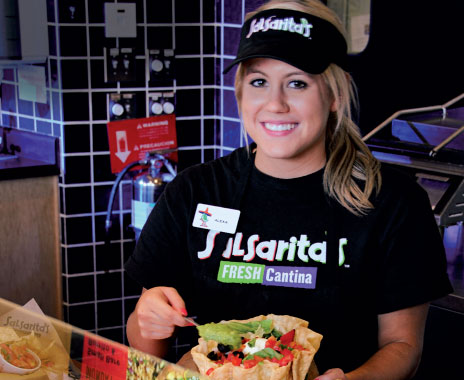Disaster can strike at any moment. That includes medical emergencies within a restaurant, something more quick-service operators are preparing their employees to deal with so customers can be protected when unexpected medical issues arise.
Salsarita’s Fresh Cantina is one brand that has committed to preparing its store managers to handle medical emergencies among both customers and employees.
“We haven’t so much saved anyone’s life, we’ve just done the right thing, making sure that if something happens, our managers are thoroughly prepared to handle it,” says Steve Kaplan, senior franchise business consultant for Salsarita’s. “It just comes down to good training through our management program. It’s extremely important for us to handle [emergencies] properly.”
Training includes providing managers with educational materials on handling emergencies, primarily slips and falls, he says.
“We pretty much teach real-life, day-to-day situations,” says Kaplan, adding that Salsarita’s conducts onsite safety meetings with store managers quarterly.
Occupational Safety and Health Administration (OSHA) regulations, established by the Occupational Safety and Health Act of 1970, apply to employers’ legal responsibility to provide safe and healthful workplaces for their employees.
However, it’s beyond the scope of OSHA’s jurisdiction to require that employers train their employees to respond to medical emergencies experienced by customers while at their place of business. OSHA also does not require employers to document the number or types of medical emergencies experienced by customers.
Nevertheless, it’s critical for quick-serve workers to receive training on recognizing and handling medical emergencies, considering that fellow diners often hesitate to jump into action when they witness someone in apparent distress, says Larry Smythe, director of Pre-Hospital Services for Mercy Fitzgerald Hospital in Darby, Pennsylvania. In fact, some customers experiencing a medical issue might even ask quick-serve workers not to call for help, Smythe says.
With proper training, though, restaurant workers are more likely to act and keep a situation stable until first responders arrive.
The better a quick serve handles an emergency, the better it is for the restaurant’s—and entire brand’s—reputation, says John Ehinger, CEO of Cardio Ready, a suburban Philadelphia company that offers cardiac emergency response programs to organizations across the U.S.
“More progressive and observant people know it’s good for the brand,” Ehinger says. “If someone has a bad episode, and [quick-serve] employees quickly intervene, what was a dire situation quickly can change into a powerfully positive event for everyone.”
“If you act and, in particular, save someone, think of the positive impact it will have on your business, especially if you get news coverage,” Smythe says. “People will say, ‘That’s where they saved the life of a guy who was choking.’”
Kaplan, however, says potential good publicity is no more than a byproduct of why Salsarita’s handles emergencies the way it does.
“It’s not why we do it. We do it because we want our guests to be safe,” he says. “If that means that people feel good about us, that’s great. But in our conversations, or when we actually think about what we’re doing, [good publicity is] not even top of mind.”
Ehinger says there are several health situations quick-service employees should be prepared for, such as seizures induced by conditions like diabetes. Choking, however, is one of the most typical medical emergencies quick-service customers or employees likely will experience, he says.
The American Heart Association (AHA) reports that most cases of foreign-body airway obstruction in adults happen while they’re eating. According to the AHA, if not relieved, choking can lead to cardiopulmonary arrest.
Cuts from sharp instruments, which are especially possible in restaurants, can also evolve into emergencies, Smythe says. Human instinct usually causes people to flee at the sight of blood, but proper training can boost the comfort level and confidence of restaurant workers in dealing with the injury, he says.
Fast feeders can access first-aid procedures and training materials from several qualified providers, Ehinger says, such as the American Red Cross and the AHA. He adds that while training is essential for each quick-serve worker, front-end workers might be better positioned to respond to an emergency sooner than those in the back of the house. An employee in the back might not immediately realize there’s a problem to begin with, he says, which can cost valuable seconds in response time.
Smythe says it also makes sense to ensure someone in the back of the house is available to provide treatment, so the store has coverage in the event of an emergency during peak hours.
No matter what their procedures look like, top management must demonstrate their commitment to training and tackle it earnestly so that the initiative is fully embraced throughout the organization, Ehinger says.
“You have to avoid a situation where people don’t take matters seriously,” he says. “[Emergency training] isn’t something you’re going to expect to use every day, but when you need it, you need it.”
Part of the commitment is making sure there are necessary funds to sustain an emergency training program, Ehinger says, adding that there’s a misperception that doing so is expensive. “If you look at providing CPR training at a [quick-serve] establishment with two shifts and five people per shift, average rates around the country run $60 a person. That’s not a massive expense,” says Ehinger, who also promotes more effective communication among employees in the event of an emergency.
Still, if cost is a sticking point among some fast-food restaurants, Smythe says, workers can learn the fundamentals of CPR through cheaper methods, like YouTube videos.
“The younger generation learns from social media, and I think it’s a way to keep costs down,” he says. “During a slow period, someone could watch a CPR demo on video and can pick up the same information that they would if an instructor was standing right in frontof them.”













